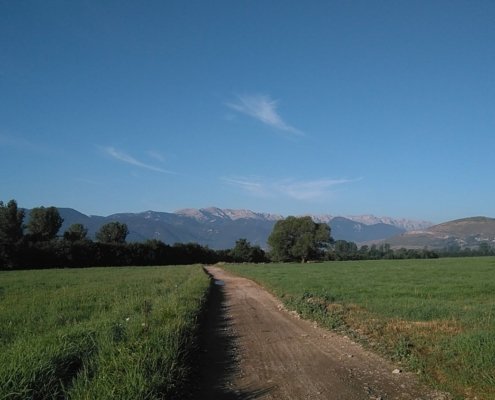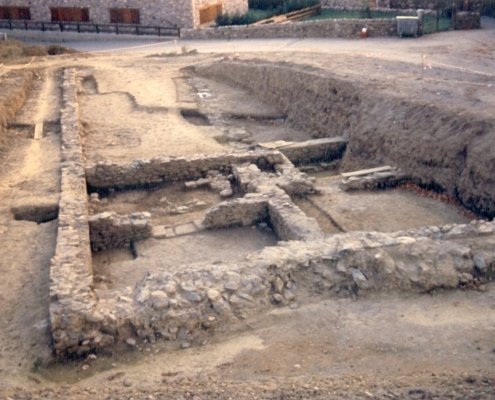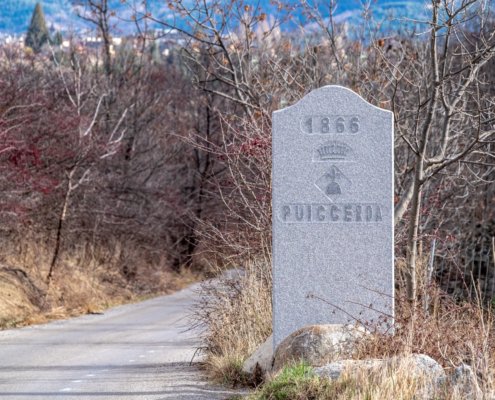La Cerdanya is a large basin of tectonic origin caused by a collapse between faults that closes the Pyrenees chain and formed an east-west oriented valley at an average altitude of 1,200 meters. This plain is surrounded by a mountainous relief belonging to the axial Pyrenees to the north and the Pre-Pyrenees to the south. This exceptional configuration has conditioned its climate, its vegetation, its fauna and its human history.
End of the Tertiary
An important lake forms in the present Batllia, surrounded by an area of wetlands. Gradually, it was filled with clays and deposits of plant origin, which gave rise to lignite deposits such as Sansor, Sanavastre and Estavar, which have been exploited over time. La Bassa de Sanavastre, remains of the old open pit mine, today is a place where botanical species from that time have been recovered.
Around 120000-50000 BC
Olopte Caves show signs of human occupation during the late Lower Paleolithic and Middle Paleolithic. According to recent studies by the University of Barcelona on glacialism in the Pyrenees, it seems very likely that the Perxa pass was free of ice during the coldest season and allowed passage to the Roussillon plain during the Paleolithic.
13000 BC
The human presence during this first moment of history is confirmed on the hill of Montlleó (Prats and Sansor) where a camp of hunters and gatherers is established during the Upper Paleolithic.
4000-3500 BC
The inhabitants of the region are beginning to be incipient farmers and ranchers. They occupy caves, shelters and open-air settlements. Wheat, sheep, goats and oxen are the basis of their diet. Vertical transhumance between winter and summer pastures in the high mountains begins at this time, a pattern that will last to this day. Sites of this time are: Sanavastre, the Fou de Bor, the caves of Olopte.
2200-1800 BC
Collective burials appear in caves such as the Fou de Bor (Bellver de Cerdanya) or the Encantades de Toloriu; but especially in the construction of megaliths. These dolmens are characterized by having two large side blocks, a third head, a roof and a smaller, front, which leaves an opening through which the deceased was deposited, are what is called “single chamber” the “Pyrenean chamber”. Within megalithism in Catalonia they are late, from the Chalcolithic to the Early Bronze Age (2000 and 1700 BC): Dolmen del Paborde a la Molina, Dolmen de coll de Fans or “Barraca del camp d’en Josepó” in Ordèn (Bellver de Cerdanya), Ca n’Aurèn I and Ca n’Aurèn II in Prullans.
Around 1500-1000 BC
Increase in the number of open-air settlements and continuity of the existing ones, occupy the hills that dominate the plain, however, occupy the middle mountain at those strategic points of vertical transhumance. Caves are used for burial and as a place of storage or temporary habitat Bronze objects arrive from the circumalpine area.
End of the s. III – s. II BC
Arrival of the Iberians, who built new settlements according to a preconceived urbanism, and made known the writing and the potter’s turn. Inscription of a large number of cave engravings located in the middle mountains. From this moment on, there are villages such as “El Castellot” in Bolvir and Turó de Gallisà in Bellver de Cerdanya. 218 BC Does Hannibal cross the Cerdanya?
83 BC
The Ceretans impose a toll on the Roman praetor Sertorius to let him cross his territory towards Ilerda.
39 BC
Revolt of the Ceretan people against the dominion of Rome, subdued by Domici Calví.
1st century BC
Iulia Lybica (Llívia), became a Roman municipality and capital of the territory. Concession of Latin law to its inhabitants. Reorganization of the rural area and the passageways (Strata Ceretana).
4th century
Existence of numerous rural settlements (villae), necropolis and other Roman elements in Llívia, Talló, Prats, Alp, Bolvir, Urtx, Baltarga.
1170-1177
Alfonso I founded the town of Puigcerdà and gave it the capital of Cerderra.
7th-8th centuries
Visigothic and Arab sources continue to cite Llívia as its capital and mention its castle for the first time. Christianity may have come through the main means of communication that crossed the territory possibly in earlier times, although it is not until this period that we find the first archaeological evidence, usually in the form of necropolises associated with temples of medieval fullness. In this sense, the aforementioned necropolis of Santa Maria de Talló, identified as Paleo-Christian, should be linked to the ancient structures located under the presbytery and the nave of the current temple, with the presence of tegulae mixed with lime and fragments of sealed African. In a similar vein, several ancient structures, located under the Romanesque churches of Santa Maria de Mosoll, Santa Maria d’All, Santa Cecília de Beders, the sanctuary of Our Lady of Pictures, Santa Eugènia de Saga and Sant Martí i Sant Serni de Vilavedra, have been related to a late ancient or Visigothic chronology, which would show the fixation of Christianity on the territory already at this time.
673
Rebellion of Duke Pau (Paulus), as a result of which King Wamba seized the castle of Llívia.
9th century
The County of Cerdanya is created. Organization of the territory in castles and parishes. Sant Esteve and Sant Hilari d’Umfred or Riufred (Vall de la Molina, Alp), will be the first monastery in Cerdà, followed by Sant Pere de Ger.
10th century
The monasteries of Sant Miquel de Cuixà and Sant Martí del Canigó receive a large number of properties in Cerdanya. In 1083. Presumable existence of Cerdanya currency.
10th-11th century
Act of Consecration of the Cathedral of Urgell in which all the churches of Cerdanya are mentioned, being the one of Talló the only one mentioned with its holder. The pagi or administrative-territorial divisions are mentioned: pagus liviensis (Llívia), pagus ollorbiensis (Olopte), pagus tolonensis (Talló) and pagus baritensis (Bar).
1182
Establishment of the Puigcerdà fair, which will be from this moment an important centralizing element of the economy of this area of the Pyrenees.
1190
King Peter I confirms the Hospital Major de Puigcerdà, which, given the enormous conceptual changes in the hospital world, will become the current hospital.
1198
The main Albigensian invasion, which damaged many churches and their belongings (Coborriu de Talló, Bor, Pedra, Urús, Beders, Baltarga, Sansor, Mosoll, Estoll, Queixans, Vilallobent, Age), as well as some farmhouses in Alp or Urtx , others.
13th century
The vegueria of Cerdanya is created, which should last until 1716.
1225
Nunó Sanç founded the town of Bellver.
1276
The county of Cerdanya is part of the Kingdom of Mallorca.
1290
Establishment of the Dominicans in Puigcerdà.
1292
The county of Cerdanya is reinstated in the Catalan Crown.
14th century
The beggars and the Jews are consolidating themselves as communities with a great specific weight within the Puigcerdano population.
Puigcerdà is the main market in the Pyrenees and is among the seven most populous Catalan towns. The textile industry became an engine of economic growth with the production of medium quality cloths, exported everywhere.
1348
First outbreak of the Black Death that will have a strong demographic impact in the region. The high mortality rate leaves the fields empty and the survivors go to the cities, where good wages are paid and freedom is obtained, while in the countryside the feudal lords impose their rights and privileges. Hunger and depopulation appear.
15th century
In 1428. A strong earthquake with its epicenter in Camprodon seriously affected the Cerdanya and a significant death toll in Puigcerdà when the church of Sant Francesc fell with the population at Mass de la Candelera, the documents speak of three hundred dead.
Catalan Civil War. 1462
King John II, in his fight for the Catalan crown, pledges the counties of Cerdanya and Roussillon in exchange for the help of Louis XI, King of France. The victory of the Catalan king will lead to the annexation of La Cerdanya to the French kingdom in the face of opposition to the subjugation of France by Llívia’s castlar, Damià Descatllar. In 1479. Louis XI, aided by Puigcerdà, besieged and destroyed the castle of Llívia, Puigcerdà definitively eliminated the rival town in the hegemony for the territory. In 1493 , Charles VIII of France returned to the counties of Cerdanya and Roussillon.
16th century
Cerdanya land of bandits “Nyerros and Puppies”. The severe political and economic instability in the territory forces the crown to get involved. In 1575 , the Union between Puigcerdà and the Sindicat de la Terra (other towns in Cerdanya) was created to deal with the numerous existing banditry.
16th-17th centuries
La Cerdanya experienced continuous clashes with France until 1659-60 , when the Treaty of the Pyrenees was signed between the Kingdom of Spain and the Treaty of France to define a border between the two states. La Cerdanya is split in two and Vila de Llívia becomes a Spanish enclave in French territory by its own decision. However, this “border” does not prevent tensions in Cerdanya territory where, unlike other Pyrenean territories, geography does not help to physically define the border. Thus in 1679 Louis XIV of France commissioned the construction of the fortress of Montlluís, and between 1708-1714 the French, under the Duke of Noailles, occupied Puigcerdà and built Fort Adrià.
1716-1833
The Castilian administration prevailed with the creation of the Puigcerdà district, which included, in addition to La Cerdanya, the Ribes valley and the current Alt Urgell.
1803
The parishes of Cerdanya on the French side no longer depend on the bishopric of Urgell.
1812-1814
Once again, the Cerdanya under Spanish administration was occupied by French troops, this time it was Napoleon who turned Puigcerdà into the capital of the Segre department. Some towns were massacred.
1833
The creation of the provincial councils and the Spanish provincial division motivate a new partition of the Cerdanya between the province of Lleida and that of Girona, which is still in force today.
Carlist wars: 1837, 1873 and 1874
Puigcerdà suffers the sieges in a heroic way and emerges victorious on all occasions. From Madrid he will receive the title “I nsigne, most faithful, heroic and always undefeated Vila de Puigcerdà”.
1886
The government gives permission to demolish the walls of Puigcerdano.
1908-1910
Beginning of the practice of snow sports in La Molina.
1914
The N-152 road, which connected Barcelona and Puigcerdà via Ribes de Freser, is ready, and the following year, the road from La Seu d’Urgell to Puigcerdà. They are two of the main regional axes of communication.
1922
The train from Barcelona arrived in Puigcerdà and in 1929 between Puigcerdà and Ax-les-Thermes.
Civil war. 1936
Great destruction of the artistic heritage of the churches of La Cerdanya under Spanish administration. A strong group of the CNT-FAI, led by Antonio Martín “el Cojo de Málaga”, bloodily controls Puigcerdà and much of La Cerdanya; in trying to win Bellver Square he is shot down and the group dismantled. The Generalitat de Catalunya is restructuring the country into counties.
1937
The municipalities of Alp, Bellver de Cerdanya, Llívia, Montellà-Martinet, Puigcerdà and Urtx issue paper money.
1939
Entry of Franco’s troops in Cerdanya. The Retreat: The border sees the avalanche of people heading north. A refugee camp is set up in the Tour de Querol.
1945-1947
Numerous casualties of Cerdans of France. The border filters those fleeing Nazism to the south and later those fleeing the Allies.
Construction of the P Line (PYRENEES) defense also known as the Gutierrez Line, in the face of a possible Allied invasion.
1956
Puigcerdà begins the practice of ice hockey in an urban center, at the state level.
1982
The region suffers from heavy rains that cause severe flooding. They directly affect Martinet and the Pont de Bar.
1984
The Cadí tunnel, which connects the Berguedà and Cerdanya counties, is open to traffic. Accessibility from Barcelona will cause important and irreversible changes in the region.
1983
The County Mountain Councils were born and in 1987 the Generalitat de Catalunya created the County Councils.
1991
Accession of Spain to the Schengen Agreement. It means the abolition of human controls and traffic restrictions on the borders between the signatory countries, the accession of Spain, softens the border with France.
February 7, 1992
Treaty on European Union or Maastricht Treaty. Birth of important cross-border projects between the Cerdanya under French and Spanish administration to solve common problems and deficiencies subsidized by Europe. Thus, in 2014 , the “Hospital Transfrontere de Cerdanya” came into operation, providing services to the population under the Spanish and French administration.




































